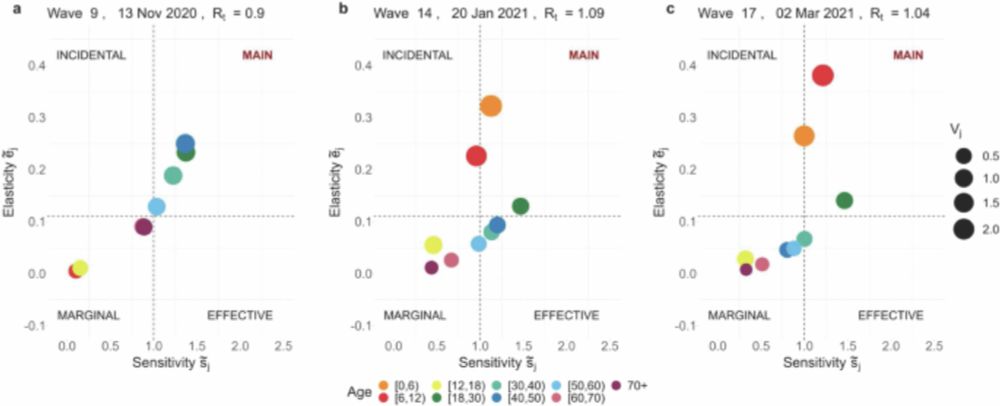
Very happy to see our new study on the evolution of eusociality come out in Evolution Letters! Our study is the first to experimentally manipulate the proportion of females that stay and help to simulate incipient sociality & assess fitness impact of helping. 🧵
23.09.2025 09:18 — 👍 26 🔁 8 💬 1 📌 1
* correct link with population genetic model appendix: www.dropbox.com/scl/fi/lq8qb...
23.09.2025 16:26 — 👍 0 🔁 0 💬 0 📌 0
* sorry and I meant "convex relationship" :-)
23.09.2025 15:54 — 👍 0 🔁 0 💬 1 📌 0
Thanks to first author Viviana Di Pietro for the fantastic work & to @ricaliari.bsky.social for overseeing the experimental work in Spain & @fwovlaanderen.bsky.social for funding! And to @andygardner.bsky.social, @lufromha.bsky.social, @kokkonut.bsky.social & @shikharabhat.bsky.social for comments!
23.09.2025 09:18 — 👍 0 🔁 0 💬 1 📌 0
Supplemental material with model details here www.dropbox.com/scl/fi/kpumz... and Mathematica notebook with the eusociality model here www.dropbox.com/scl/fi/h7ery...
23.09.2025 09:18 — 👍 0 🔁 0 💬 1 📌 0
Overall, our work clarifies how demographic benefits of early cooperation can cause eusociality to evolve more easily, thereby providing a new perspective on a major evolutionary transition and resolving a long-standing paradox.
23.09.2025 09:18 — 👍 0 🔁 0 💬 1 📌 0

Theoretical results show that the observed benefits of helping readily allow for the evolution of eusociality, although most readily so with alleles of large effect (penetrance parameter P=1, bottom row) & under single mating (me=1), when sib-sib relatedness is high.
23.09.2025 09:18 — 👍 0 🔁 0 💬 1 📌 0

We then use our experimental data to parameterize a population genetic model for the evolution of eusociality, with opposing among-group & within-group selection on a eusociality allele.
23.09.2025 09:18 — 👍 1 🔁 0 💬 1 📌 0

Theoretically, we show that these nonlinearities arise from compounding effects of helping early on: workers produced early on help to produce more workers before dispersing sexuals are produced.
23.09.2025 09:18 — 👍 0 🔁 0 💬 1 📌 0

Our experimental data from Polistes gallicus paper wasps show that there is a concave relationship between the final number of sexuals reared and the proportion of females that stay & help. This shows there are large benefits of helping, but that these are also highly nonlinear.
23.09.2025 09:18 — 👍 0 🔁 0 💬 1 📌 0

Very happy to see our new study on the evolution of eusociality come out in Evolution Letters! Our study is the first to experimentally manipulate the proportion of females that stay and help to simulate incipient sociality & assess fitness impact of helping. 🧵
23.09.2025 09:18 — 👍 26 🔁 8 💬 1 📌 1


We are delighted that our Winter Meeting 2025 in Leuven 🇧🇪 is approaching!
Abstract submissions now open: www.iussi-nweurope.org/meetings
Date: December 18-19
Abstract deadline: October 15
Host: Laboratory of Socioecology and Social Evolution at KU Leuven
Plenary: Ido Pen & @rmash.bsky.social
13.09.2025 07:22 — 👍 16 🔁 15 💬 1 📌 1
Free PDF of a highly recommended book: "High-Dimensional Regression Modeling" (2024) by Patrick Breheny and Jian Huang. myweb.uiowa.edu/pbreheny/7240/s25/book.pdf with reproducible R code at github.com/pbreheny/hdrm. Accompanying lecture notes & R scripts here: myweb.uiowa.edu/pbreheny/724....
27.08.2025 08:53 — 👍 3 🔁 1 💬 1 📌 0

📌North-West European IUSSI Winter Meeting 2025
We are happy to announce that our next meeting on the 18–19 December 2025 will be in Leuven, Belgium, hosted by @twenseleers.bsky.social and his team.
Plenary speakers: Ido Pen & Rahia Mashoodh @rmash.bsky.social
More details to follow 🐝🐜🪳🪲
26.08.2025 13:09 — 👍 11 🔁 8 💬 0 📌 0

How often are children genetically unrelated to their presumed fathers?
Tackling a touchy subject, genetic detective finds only 1% of European children have unexpected paternity
Honoured to see an article about my research on extra-pair paternity in @science.org. Many thanks to journalist @spoke32.bsky.social for the story and to all colleagues for their quotes!
Hopefully, future visitors to my office will be less surprised by a (reproduction) 17th-century painting...
07.03.2025 23:03 — 👍 43 🔁 13 💬 1 📌 2
Big congrats Maarten!
18.03.2025 20:28 — 👍 1 🔁 0 💬 0 📌 0
Well Swiss NSF has 15% overhead and Belgian FWO has 6% overhead. But hard to compare countries...
08.02.2025 21:34 — 👍 1 🔁 0 💬 0 📌 0
Yes I get that - a greater share of the operating costs of European universities is state funded compared to in US public universities. But I would still find it a little excessive that for a 1 million USD grant 0.5 million would be needed to pay for the heating & cleaning of my lab & admin support.
08.02.2025 13:27 — 👍 4 🔁 0 💬 3 📌 0
What do you mean exactly? It just struck me that those high overheads in the US don't seem to translate into making their universities more democratic. Tuition fees are sky high. But OK taxes are a little higher in Europe...
08.02.2025 12:34 — 👍 2 🔁 0 💬 1 📌 0
In Belgium the overhead on FWO projects is 6% and the Swiss NSF has 15% overhead. EU horizon 25%. Why are the percentages so much higher in the US?
08.02.2025 12:06 — 👍 7 🔁 1 💬 6 📌 0
If you opted-in then in principle - yes, any confidential fine grained facts could leak into the next model. But not if you opt out. Example above is a bit more tricky: the student could opt in, but the lecturer might prefer this material not to be used as training material for the next model...
04.01.2025 23:44 — 👍 0 🔁 0 💬 1 📌 0

How your data is used to improve model performance | OpenAI Help Center
Learn more about how OpenAI uses content from our services to improve and train our models.
Well from what is written there it seems if you opt in they can use your chats to help train subsequent models & presumably also use it for the RLHF part. But before doing so they would remove any personal information. So in example above the course material could become part of the training set.
04.01.2025 23:35 — 👍 0 🔁 0 💬 1 📌 0
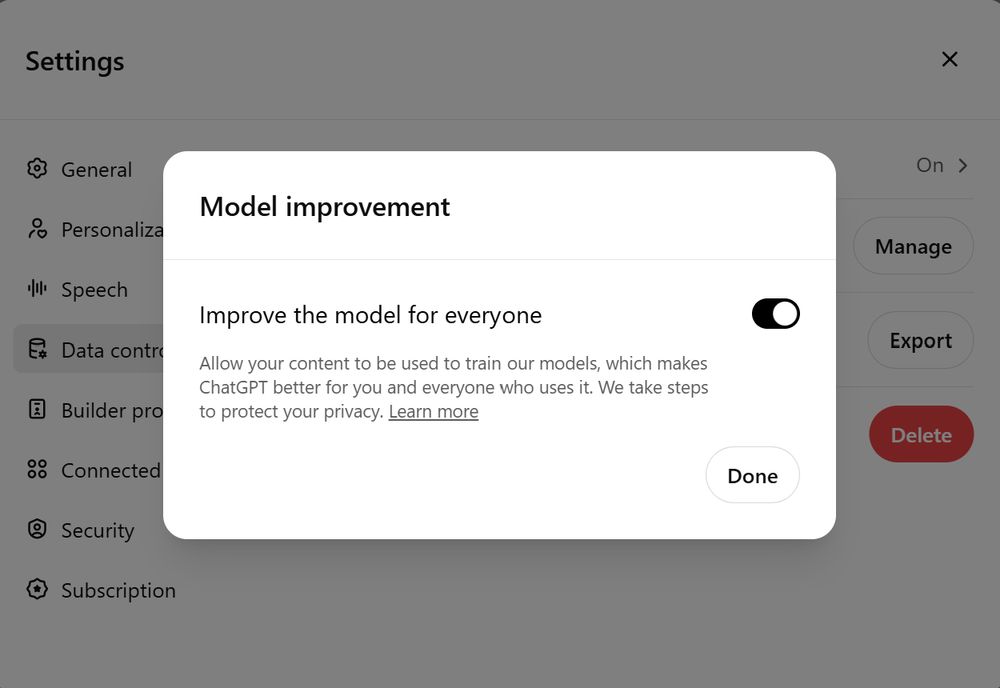
That option of allowing your data to be used for the next model can be switched on or off in the settings... But yes, a bit tricky potentially when people are pasting in copyrighted material. I recall that when you paste in PDFs you are not allowed to publicly share those conversations though.
04.01.2025 23:25 — 👍 1 🔁 0 💬 1 📌 0
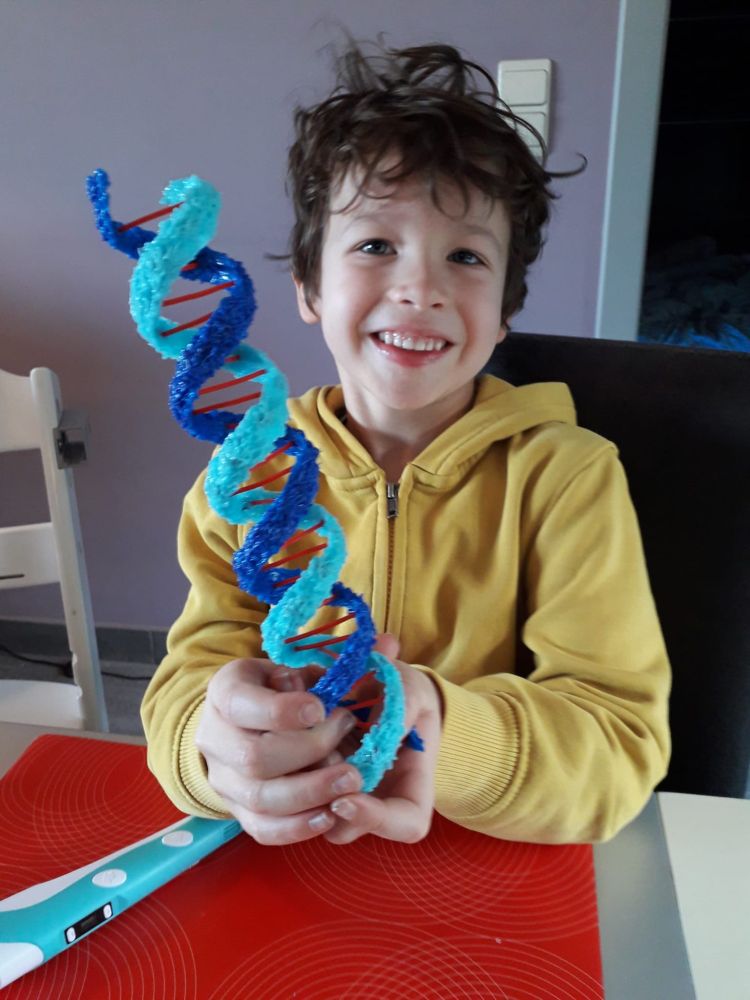
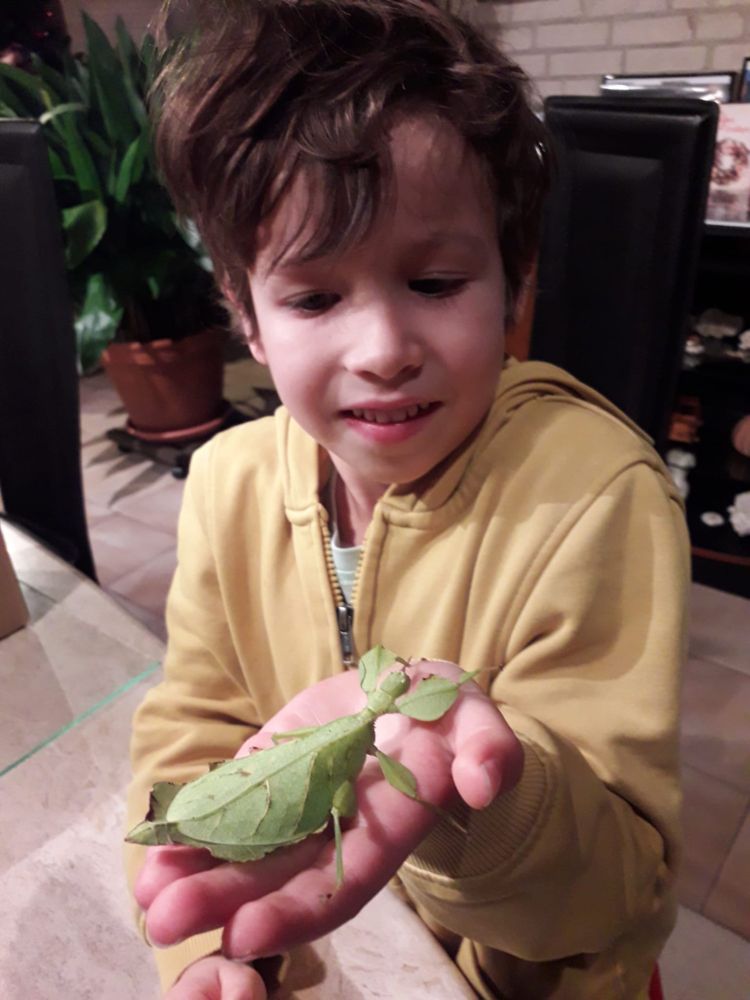
Happy New Year to you all! My Christmas holidays involved helping my son make a DNA molecule model using a 3D pen & getting a new pet for him: leaf insects! Great fun!
04.01.2025 22:47 — 👍 3 🔁 0 💬 0 📌 0
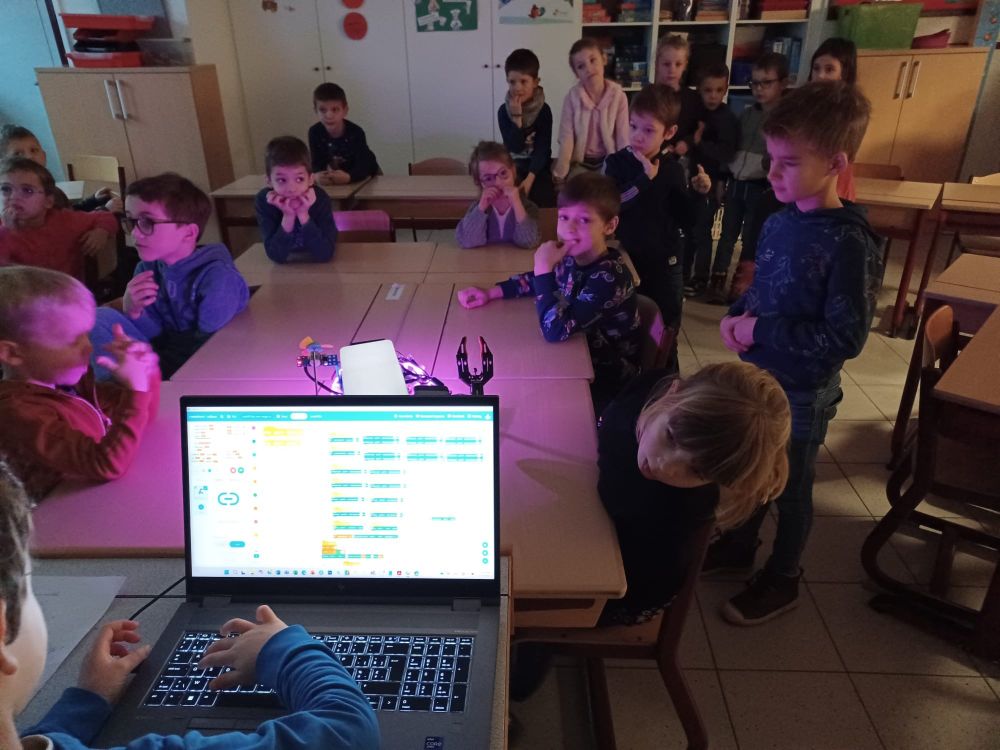
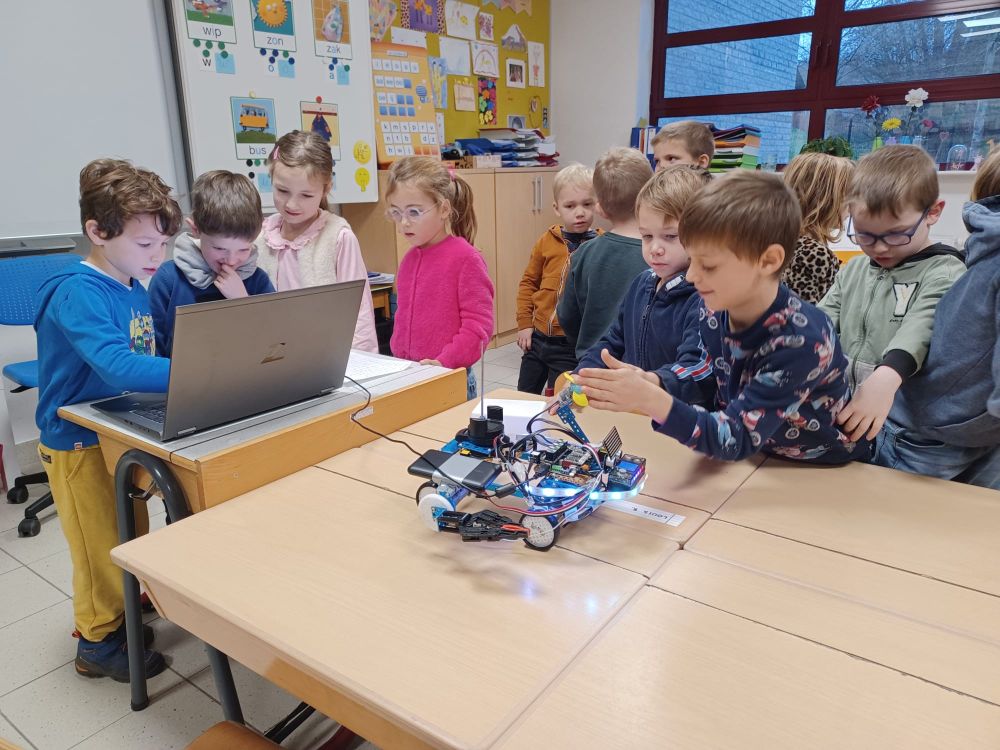
In first grade we just demonstrated a Makeblock robot with a mobile phone mounted on its back with ChatGPT Advanced Voice Mode, to pretend the robot was able to talk! The kids & teacher absolutely loved it! It answered all the kids' questions for a full hour! It could even talk with a robot voice!
16.12.2024 20:30 — 👍 7 🔁 0 💬 1 📌 0
Well since it needed about twice as much time to do the 35 questions (almost 40 minutes instead of the 25 allowed minutes) it was not particularly fast no. With 40 minutes it got an IQ of 88. For a vision AI that's very good - other vision AIs only get around 70. But I had expected more...
12.12.2024 06:33 — 👍 0 🔁 0 💬 0 📌 0
That's definitely not true - in nearly all of the benchmarks ChatGPT o1-preview comes out as the best model & for most of my coding needs & scientific work it works admirably well. An IQ score of 88 is still quite a good score for a vision AI. Previously, the best vision AIs only got around 70.
12.12.2024 06:16 — 👍 1 🔁 0 💬 0 📌 0
Stanford University Press has been publishing books across the humanities, social sciences, law, business, and other areas since 1892.
Postdoc and Kokkonut @uni_mainz - evolutionary theory (sexual conflict, selfish genes etc) and other things (which is really just bike riding)
Postdoc researcher at KCL interested in ageing, genetics, epigenetics, and transcriptomics.
Teacher. Learner. Investigating mysteries of SARS-CoV-2 evolution. LongDesertTrain on another platform.
Post doc- sexual selection, life history
Mathematics Sorceror (sensory alchemist) at the Arctangent Transpetroglyphics Algra Laboratory (ATAL), I transflarnx mathematics into living rainbows. http://owen.maresh.info https://github.com/graveolensa
Psoeppe-Tlaxtlal, (an undreamt splendour?)
Assistant Professor in the Department of Entomology at Virginia Tech. My research is on mapping #HoneyBee waggle dances and airborne environmental DNA (#eDNA). I am interested in #Emacs, #Orgmode, and #Rstats. Also at @schuemaa@ecoevo.social.
Executive Director at CUNY ASRC, comparative psychology professor at GC CUNY with an eye on brood parasites; Nat Geo Explorer, married 🏳️🌈; I post my own mind. www.cowbirdlab.org
To get something you never had, you have to do something you never did
Do the mahi, get the treats
He/him | 38 | Lifelong explorer and learner | 🦋Reylo | ⏹️Stop AI
MSc Animal Behaviour (Queen's University Belfast) interested in animal cognition and social behaviours
https://linktr.ee/robotowilliam
Colombian 🇨🇴 PhD student @ KU Leuven || Bioinformatician || Eco-evolutionary genomics 🪲🦋🕷️ Studying the evolutionary role of chromosomal inversions in beetles
🏳️⚧️ 🏳️🌈 🇵🇸
Behavioural and evolutionary ecologist, lecturer in Bangor, Wales - sociality, stress, mostly in reptiles macleodlab.weebly.com
Professor Emeritus (University of Manchester), writes on biology, history of science & French Resistance. Biography of Francis Crick, out in Nov 2025.
Link to publications: https://orcid.org/0000-0002-8258-4913
UCL Research Fellow in epigenetics, inheritance, and behaviour. Lover of R, tinkering and food. Sometimes I hurt myself bicycling. 🪲🇨🇦🚲
International Union for the Study of Social Insects
https://iussi.de/
Evolutionary ecologist @ the University of Milan - Italy. Interested in genes, behaviour, pollinators and many other things.
https://fabiomanfredini.com/
Freelance journalist. Science writer.
Studying metabolic evolution, microbial macroevolution, biospheric self-organization, and the feedbacks between Earth and life. Dad, Husband, Scientist.
https://rogierbraakman.com/
PI: Prof. Luc De Meester | limnology, eco-evolutionary dynamics, metacommunity ecology, env. genomics, Daphnia biology, microbial ecology and evolution 💦🌍🦠
KU Leuven, Leuven, Belgium
bio.kuleuven.be/eeb/ldm
We study socially transferred materials, metabolic division of labour, and the evolution of cooperation. Mostly ants, sometimes microbes, sometimes vertebrates.
PI = @adriatica.bsky.social, Lab is @camzoology.bsky.social at University of Cambridge.










